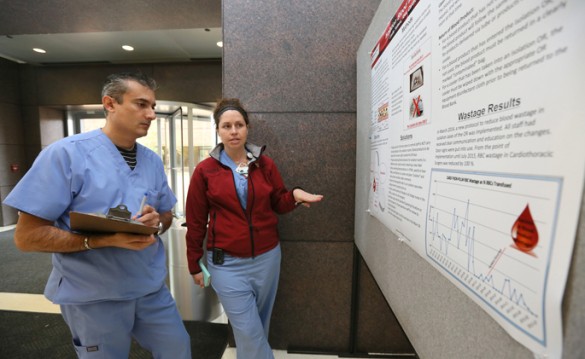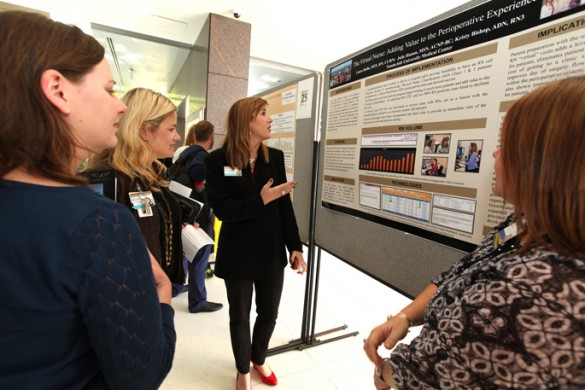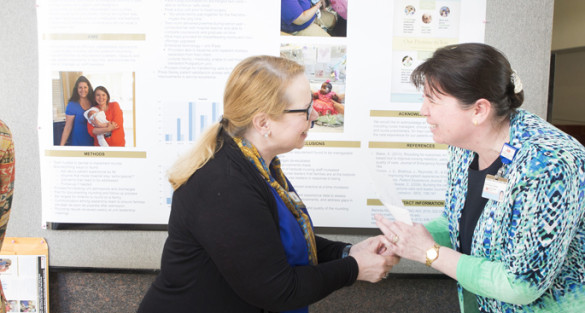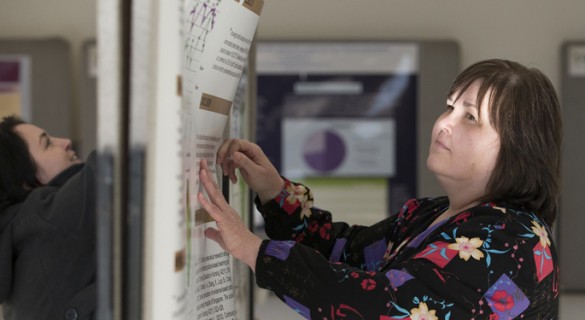
Nursing research was on full display on Oct. 28 in Light Hall during the Research Day Poster Presentations, organized by the Evidence-Based Practice (EBP) and Nursing Research Committee.
Hundreds of Vanderbilt nurses, members of Sigma Theta Tau, Vanderbilt University School of Nursing faculty, students and others attended the annual event, part of the weeklong Octoberfest 2015, which was devoted to evidence-based practice.
“Really, it all has to do with how can we get our patients back home in the quickest way possible, and once they’re at home how can we help them stay there and stay healthy,” said Nancy Wells, DNSc., R.N., director of Nursing Research at VUMC.
Wells’ office is a resource for nurses interested in research, offering consultation, help in locating funding, setting up instruments and working with statisticians. Her office also helps them put together the posters and write for publication.
“The investigative efforts of our nurses directly support a key goal of the VUMC Nursing Strategic Plan,” said Jill Clendening, program coordinator for Nursing Research.
“Our nurses’ research initiatives and the resulting improvements in patient care are also a big part of the voluminous documentation required to earn Magnet designation from the American Nurses Credentialing Center. Our nurses are deep in the trenches right now putting materials together for the next Magnet review, so they have a lot to report.”
Thirty posters were featured this year, showcasing a range of research across the Medical Center. The top three posters received monetary awards from the Iota Chapter of nursing honor society Sigma Theta Tau, which was founded at VUSN in the 1920s.
The winners were:
• First Place — Leslie Yatteau, R.N., “Isolation Blood Wastage in the OR.”
• Second Place — Sonya Moore, MSN, R.N.; Jenny Slayton, MSN, R.N.; Julia Matthews; Henry Domenico, M.S.; Robin Holbrook, MBA, R.N.; Phil Cook, MHA; Matt Mulvey; Lydia Shellman; and Neesha Choma, M.D., MPH; for “Using Data to Decrease Falls and Standardized Best Practices in Fall Prevention.”
• Third Place — Phil Cook, MHA, and Kathie Wilkerson, R.N.; Jennifer McNaught, R.N., for “Using a Lean, Multidisciplinary Approach to Prevent C. difficile.”
Wilkerson said her team looked at antibiotic use, cleaning and how items are transferred in and out of rooms with patients in isolation as well as patient hygiene. Nurses were also empowered to order C. diff tests, which resulted in tests being returned nine hours faster than the traditional ordering mechanism.
“If the tests come back negative, then the nurse can take the patient off isolation, which decreases the amount of supplies being used and increases the amount of nursing time,” Wilkerson said.
Moore talked about how her team used fall prevention data to determine which units were at the highest risk for falls, and shared data with select units, coming up with an action plan. The result was a 31 percent decrease in falls with harm in the units studied from June 2014 to July 2015.
“The fact that these units were able to embrace this work … the results are really showing,” she said.
Yatteau took top honors for her work in reducing blood wastage in the OR. She noticed that blood products were being wasted because they were taken into rooms with patients in isolation.
“It really made me want to try to find a way to figure out a process and a solution to that not happening again because products are so expensive,” she said.
She remedied the situation by educating staff, messaging blood bank personnel about isolation patients and making signs asking for blood product not to be brought into isolation rooms without following proper protocol. The result was zero blood product wastage during the four-month trial.
Clendening is gratified with the results.
“Because nurses are consistently at the bedside, they can quickly identify issues related to patient care that warrant further examination,” she said. “We have many nurses that have presented their work at national conferences, that have been published in leading nursing and health care scholarly journals and that have produced solid science leading to improvements in patient care, safety and efficiency.”















